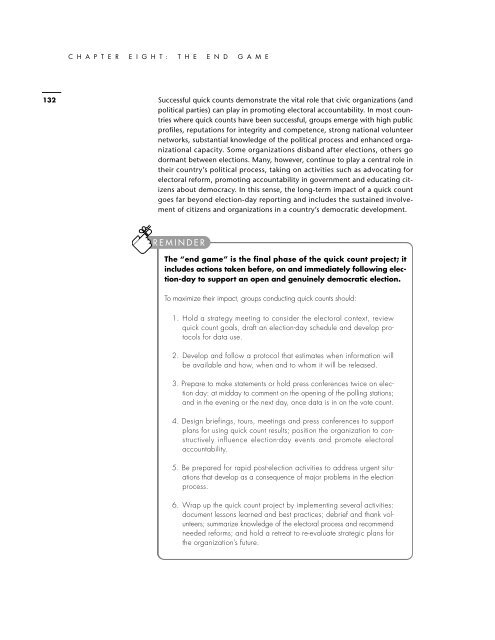The Quick Count and Election Observation
The Quick Count and Election Observation
The Quick Count and Election Observation
Create successful ePaper yourself
Turn your PDF publications into a flip-book with our unique Google optimized e-Paper software.
C H A P T E R E I G H T : T H E E N D G A M E<br />
132 Successful quick counts demonstrate the vital role that civic organizations (<strong>and</strong><br />
political parties) can play in promoting electoral accountability. In most countries<br />
where quick counts have been successful, groups emerge with high public<br />
profiles, reputations for integrity <strong>and</strong> competence, strong national volunteer<br />
networks, substantial knowledge of the political process <strong>and</strong> enhanced organizational<br />
capacity. Some organizations disb<strong>and</strong> after elections, others go<br />
dormant between elections. Many, however, continue to play a central role in<br />
their country’s political process, taking on activities such as advocating for<br />
electoral reform, promoting accountability in government <strong>and</strong> educating citizens<br />
about democracy. In this sense, the long-term impact of a quick count<br />
goes far beyond election-day reporting <strong>and</strong> includes the sustained involvement<br />
of citizens <strong>and</strong> organizations in a country’s democratic development.<br />
<strong>The</strong> “end game” is the final phase of the quick count project; it<br />
includes actions taken before, on <strong>and</strong> immediately following election-day<br />
to support an open <strong>and</strong> genuinely democratic election.<br />
To maximize their impact, groups conducting quick counts should:<br />
1. Hold a strategy meeting to consider the electoral context, review<br />
quick count goals, draft an election-day schedule <strong>and</strong> develop protocols<br />
for data use.<br />
2. Develop <strong>and</strong> follow a protocol that estimates when information will<br />
be available <strong>and</strong> how, when <strong>and</strong> to whom it will be released.<br />
3. Prepare to make statements or hold press conferences twice on election<br />
day: at midday to comment on the opening of the polling stations;<br />
<strong>and</strong> in the evening or the next day, once data is in on the vote count.<br />
4. Design briefings, tours, meetings <strong>and</strong> press conferences to support<br />
plans for using quick count results; position the organization to constructively<br />
influence election-day events <strong>and</strong> promote electoral<br />
accountability.<br />
5. Be prepared for rapid post-election activities to address urgent situations<br />
that develop as a consequence of major problems in the election<br />
process.<br />
6. Wrap up the quick count project by implementing several activities:<br />
document lessons learned <strong>and</strong> best practices; debrief <strong>and</strong> thank volunteers;<br />
summarize knowledge of the electoral process <strong>and</strong> recommend<br />
needed reforms; <strong>and</strong> hold a retreat to re-evaluate strategic plans for<br />
the organization’s future.


